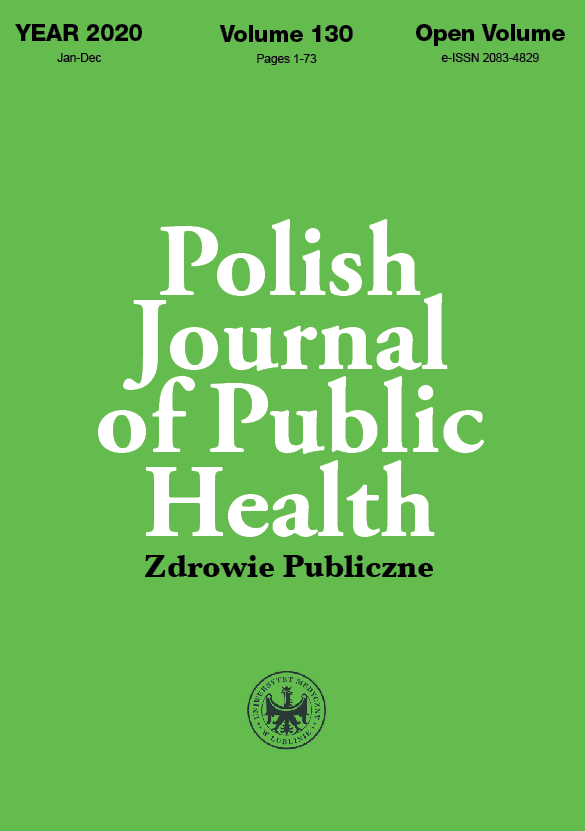Correlation between air pollution in Lublin and the numberof hospitalizations due to exacerbations of chronic lung and cardiovascular diseases
DOI:
https://doi.org/10.2478/pjph-2020-0016Słowa kluczowe:
particulate matter, air humidity, heart diseases, lung diseasesAbstrakt
Introduction. Air pollution exacerbates chronic lung and cardiovascular diseases. The greatest importance is assigned to dusts with a diameter of 2.5 μm (PM 2.5) and a diameter of 10 μm (PM 10) resulting from the combustion of solid fuels.
Aim. The aim of the study was to investigate the correlation between air pollution in Lublin in 2019 and the number of hospitalizations due to exacerbations of chronic lung and heart diseases.
Material and methods. The material was collected in Lublin from January 1st 2019 to December 31st 2019. The concentration of PM 2.5, PM 10 dust, air temperature and humidity were measured with the DM106A sensor. Data on the number of hospitalizations were obtained from the Independent Public Clinical Hospital No. 4 (SPSK 4) in Lublin. The material was statistically analyzed with the IBM SPSS Statistics package. The obtained results of the analysis were considered statistically significant at p<0.05.
Results. The average annual humidity was 59.1%, the concentration of PM 2.5 was 24.9 μg/m3, and PM 10 was 33 μg/m3. Dust concentrations increased at the beginning of heating season in October. They were high till the end of March. They fell in the spring. With increasing air humidity, there were more hospitalizations due to exacerbation of lung diseases. Men and women were more often admitted to hospital due to exacerbations of cardiovascular diseases than lung problems.
Conclusions. In low air temperatures during heating season dust concentrations increase but they do not affect the number of hospitalizations in Lublin. Air humidity is the factor correlated with admissions to hospital of both men and women with lung and heart diseases
Bibliografia
1. Grzywa-Celińska A, Krusiński A, Milanowski J. ‘Smoging kills’ – Effects of air pollution on human respiratory system. Ann Agric Environ Med. 2020;27(1):1-5.
2. Pope CA 3rd, Burnett RT, Thurston GD, et al. Cardiovascular mortality and long-term exposure to particulate air pollution: epidemiological evidence of general pathophysiological pathways of disease. Circulation. 2004;109(1):71-7.
3. Orru H, Ebi KL, Forsberg B. The Interplay of climate change and air pollution on health. Curr Environ Health Rep. 2017;4(4):504-13.
4. Kim KH, Kabir E, Kabir S. A review on the human health impact of airborne particulate matter. Environ Int. 2015;74:136-43.
5. Gasparrini A, Guo Y, Hashizume M, Kinney PL, et al. Temporal variation in heat-mortality associations: A multicountry study. Environ Health Perspect. 2015;123(11):1200-7.
6. Capon A, Corvalan C. Climate change and health: global issue, local responses. Public Health Res Pract. 2018;28(4):2841823.
7. Wojtyniak B, Goryński P. Sytuacja zdrowotna ludności Polski i jej uwarunkowania. Warszawa: Narodowy Instytut Zdrowia Publicznego – Państwowy Zakład Higieny; 2018.
8. Liebhart J, Dobek R, Małolepszy J, Wojtyniak B, et al. The prevalence of Allergic Diseases in Poland – the results of the PMSEAD Study in relation to gender differences. Adv Clin Exp Med. 2014;23(5):757-62.
9. Jankowski P. Zasady profilaktyki chorób układu krążenia w 2018 roku. Kardiol Inwazyjna. 2017;5(12):42-8.
10. Główny Inspektorat Ochrony Środowiska [http://powietrze.gios.gov.pl/]
11. Główny Inspektorat Ochrony Środowiska: Analiza wybranych epizodów wysokich stężeń pyłu PM10 z lat 2013-2016. Etap II Epizody z lat 2015- 2016. Warszawa: Główny Inspektorat Ochrony Środowiska; 2017.
12. World Health Organization. Air quality guidelines for particulate matter, ozone, nitrogen dioxide and sulfur dioxide: global update 2005: summary of risk assessment. Geneva: World Health Organization; 2006.
13. World Health Organization. Health risks of air pollution in Europe – HRA PIE project. Recommendations for concentration–response functions for cost – benefit analysis of particulate matter, ozone and nitrogen dioxide. WHO Regional Office for Europe. World Health Organization; 2013.
14. World Health Organization. Review of evidence on health aspects of air pollution – RE VIHAA P Project. Technical Report; 2013.
15. World Health Organization Regional Office for Europe. Review of evidence on health aspects of air pollution – REVIHAAP project: final technical report. World Health Organization; 2013.
16. Slama A, Śliwczyński A, Woźnica J, et al. Impact of air pollution on hospital admissions with a focus on respiratory diseases: a time-series multi-city analysis. Environ Sci Pollut Res Int. 2019;26(17):16998-7009.
17. Konduracka E, Niewiara Ł, Guzik B, et al. Effect of short-term fluctuations in outdoor air pollution on the number of hospital admissions due to acute myocardial infarction among inhabitants of Kraków, Poland. Pol Arch Intern Med. 2019;129(2):88-96.
18. Cichowicz R, Wielgosiński G, Fetter W. Dispersion of atmospheric air pollution in summer and winter season. Environ Monit Assess. 2017;189(12):605.
19. Dyląg KA, Wroński B, Przybyszewska K, Dumnicka P. Air pollution is associated with incidence of viral croup among children living in Kraków area, Poland. Folia Med Cracov. 2018;58(1):69-79.
20. Andree BPJ. Incidence of COVID-19 and Connections with Air Pollution. Exposure: Evidence from the Netherlands. Policy Research Working Paper 9221.World Bank Group; 2020.
21. Sharma AK, Balyan P. Air pollution and COVID-19: Is the connect worth its weight? Indian J Public Health. 2020;64(Supplement):S132-S134.
22. Sciomer S, Moscucci F, Magrì D, et al. SARS-CoV-2 spread in Northern Italy: what about the pollution role? Environ Monit Assess. 2020;192(6):325.
23. Zoran MA, Savastru RS, Savastru DM, Tautan MN. Assessing the relationship between surface levels of PM2.5 and PM10 particulate matter impact on COVID-19 in Milan, Italy. Sci Total Environ. 2020;738:139825.
24. Fattorini D, Regoli F. Role of the chronic air pollution levels in the Covid-19 outbreak risk in Italy. Environ Pollut. 2020;264:114732.
25. Hennig F, Fuks K, Moebus S, et al. Nixdorf Recall Study Investigative Group. Association between source-specific particulate matter air pollution and hs-CRP: local traffic and industrial emissions. Environ Health Perspect. 2014;122(7):703-10.
26. Li Y, Rittenhouse-Olson K, Scheider WL, Mu L. Effect of particulate matter air pollution on C-reactive protein: a review of epidemiologic studies. Rev Environ Health. 2012;27(2-3):133-49.
Pobrania
Opublikowane
Numer
Dział
Licencja
Prawa autorskie (c) 2021 Polish Journal of Public Health

Praca jest udostępniana na licencji Creative Commons Attribution-NonCommercial-NoDerivatives 3.0 Unported License.


